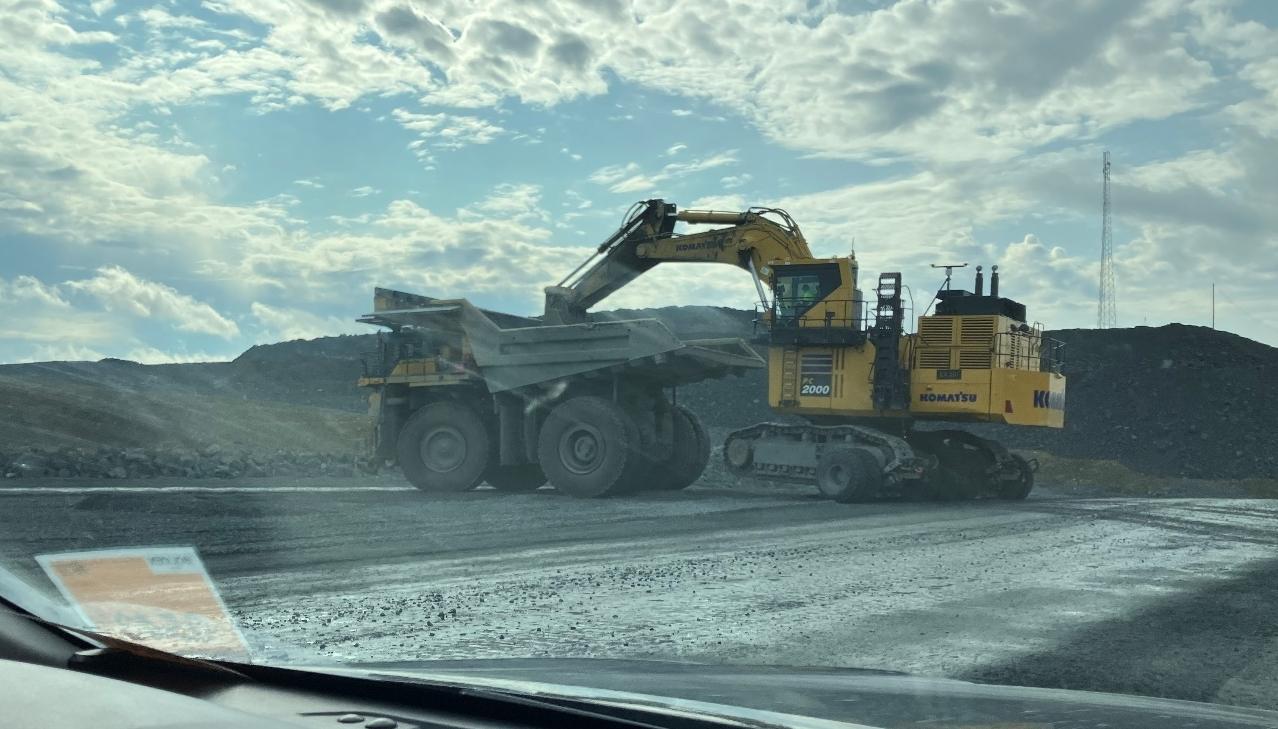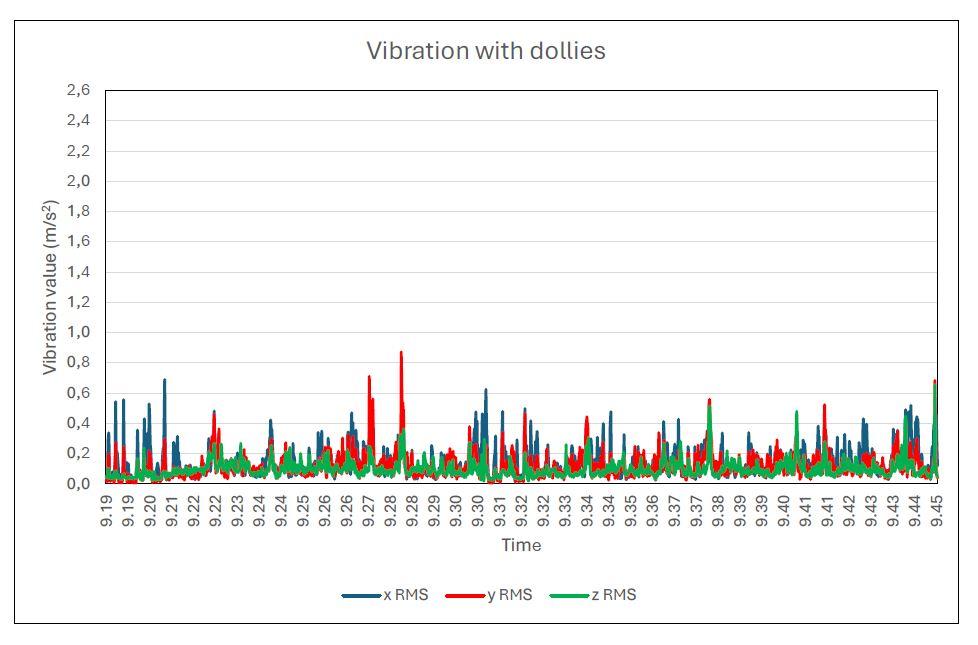
Reference: Vili Tuominen/vibration measurement
THIS REPORT REPLACES EARLIER REPORT 14.6.2023 TTL23-02551 B


Reference: Vili Tuominen/vibration measurement
THIS REPORT REPLACES EARLIER REPORT 14.6.2023 TTL23-02551 B
1General
Vibration measurements were conducted at a Finnish mine site on 24 May 2023. The aim was to measure the level of the workers’ exposure to whole-body vibration when driving an excavator from one site to another on tracks and Sleipner E series transport wheels.
Specialised Occupational Hygienist Ville Hyvärinen from the Oulu office of the Finnish Institute of Occupational Health conducted the measurements and prepared this report. Product Engineer Vili Tuominen took part in the measurements as a representative of Sleipner Finland Oy.
The measurements were carried out on the transport route of the mine’s open quarry area. Testing route was kept the same during both tests. The surface was a gravel road and it’s good condition had been ensured with a road grader. The excavator used for the test was a Komatsu PC 2000 and, when using transport wheels, the excavator was pulled with a Komatsu 830 E haul truck. During the measurements, the weather was clear and the transport route had been wetted to prevent dust.



3Methods
The methods for measuring whole-body vibration and processing data are specified in standard ISO 2631-1:1997. The measurements were performed with a Larson Davis HVM 200 vibration meter by placing the meter’s PCB356B41 acceleration sensor on the driver’s seat of the excavator for the duration of the measurements. The operation of the vibration equipment (meter and sensor together) was checked with a PCB394C06 calibrator before the measurements. During the measurements (26 minutes on wheels and 20 minutes on tracks) the driver and the person conducting the measurements were in the excavator cab.
Vibration acceleration is measured in three directions that are perpendicular to each other. When observing whole-body vibration, three directional components awx, awy, and awz (where x is the worker’s horizontal front-facing direction, y is the horizontal lateral direction and z is vertical vibration) are examined separately and the exposure is assessed based on the highest level. The horizontal vibration values (ax and ay) are multiplied by 1.4 before comparing the result with the reference values.
Vibration exposure A(8) is calculated from the strength of the vibration (measurement result) and estimated exposure times, as required by Government Decree 48/2005. The exposure is determined in proportion to an eight-hour comparison period. Another way to assess the risk is to determine the calculated time after which the measured level of vibration causes exposure that exceeds the action value or limit value.
4Reference values
According to Government Decree 48/2005, the action value for daily whole-body vibration A(8) is 0.5 m/s2 and the limit value is 1.15 m/s2
5Results and discussion
The measured vibration accelerations are presented in Table 1. The time of exceeding the action value and limit value has been calculated based on the most harmful direction (highest vibration acceleration). The figures drawn from the measurement values are presented in Appendix 1.
Table 1. Whole-body vibration results.
Excavator
When driving on transport wheels, the highest average vibration acceleration is 0.23 m/s2 which was measured in the driver’s front-facing direction (forwards–backwards direction). At the measured level of vibration acceleration, neither the action value nor the limit value are exceeded during a normal 12-hour working day.
When driving on tracks, the highest average vibration acceleration of 0.82 m/s2 was measured in the driver’s front-facing and lateral directions. At the measured level of vibration acceleration, the action value level is exceeded after three hours of exposure. Exposure


exceeding the limit value requires about 16 hours of driving, which means that the value is not exceeded during a normal 12-hour working day.
As regards vibration exposure, the risk classifications can be combined with the exposure reference values specified in Government Decree 48/2005 as follows:
• The risk is significant when the daily exposure exceeds the action value (whole-body vibration 0.5 m/s2). A vibration prevention programme and measures to reduce vibration are needed. If the exposure also exceeds the limit value (1.15 m/s2), the measures to reduce exposure must be carried out immediately.
• The risk is moderate when the exposing vibration can exceed the action value but the daily exposure level does not reach the action value (50–99%).
• The risk is minor when the exposure is sporadic and/or low (less than 50% of the action value).
Based on the vibration measurements conducted and other observations:
• When wheels are used to transport the excavator, the level of whole-body vibration is low and remains below the action value specified in Government Decree 48/2005, even if the exposure lasts the entire working day. 50% of the action value is reached after about 10 hours of exposure, which can be regarded as the maximum exposure time during a normal 12 hour working day. Generally speaking, the health risk caused to workers can be considered to be minor.
• When the excavator is moved between sites on its own tracks, the exposure to wholebody vibration is significantly higher and the action value level specified in Government Decree 48/2005 is reached in three hours. 50% of the action value is reached in about 45 minutes. In other words, the health risk to workers can rise to a moderate or even significant level quite easily.
Using transport wheels significantly reduces the workers’ exposure to whole-body vibration and the resulting health risk, emerging as an excellent way to mitigate vibration. Reducing vibration also improves work comfort, as does a lower sensory noise level in the excavator cab.


8References
1.Finnish Government Decree 48/2005.
2.ISO 2631-1:1997: Mechanical vibration and shock -- Evaluation of human exposure to whole-body vibration -- Part 1: General requirements.
3.Murtonen, Riskien arviointi työpaikalla. Ministry of Social Affairs and Health, Department of Occupational Health and Safety and Centre for Occupational Health, 2015.
I hereby approve this report and confirm this is the final version of the statement prepared by Specialised Occupational Hygienist Ville Hyvärinen. We will willingly answer any questions regarding this report and its content. Our primary contact person is the author of the report Ville.Hyvarinen@ttl.fi, or +358 (0)43 8241274.
Ikäheimo Marko, Specialised Occupational Hygienist
The document has been signed electronically. The certificate details are on the last page of the document.
APPENDICES 1. Measurement results


Measurement results



Vibration with tracks
Vibration value (m/s 2 )
x RMS y RMS z RMS
